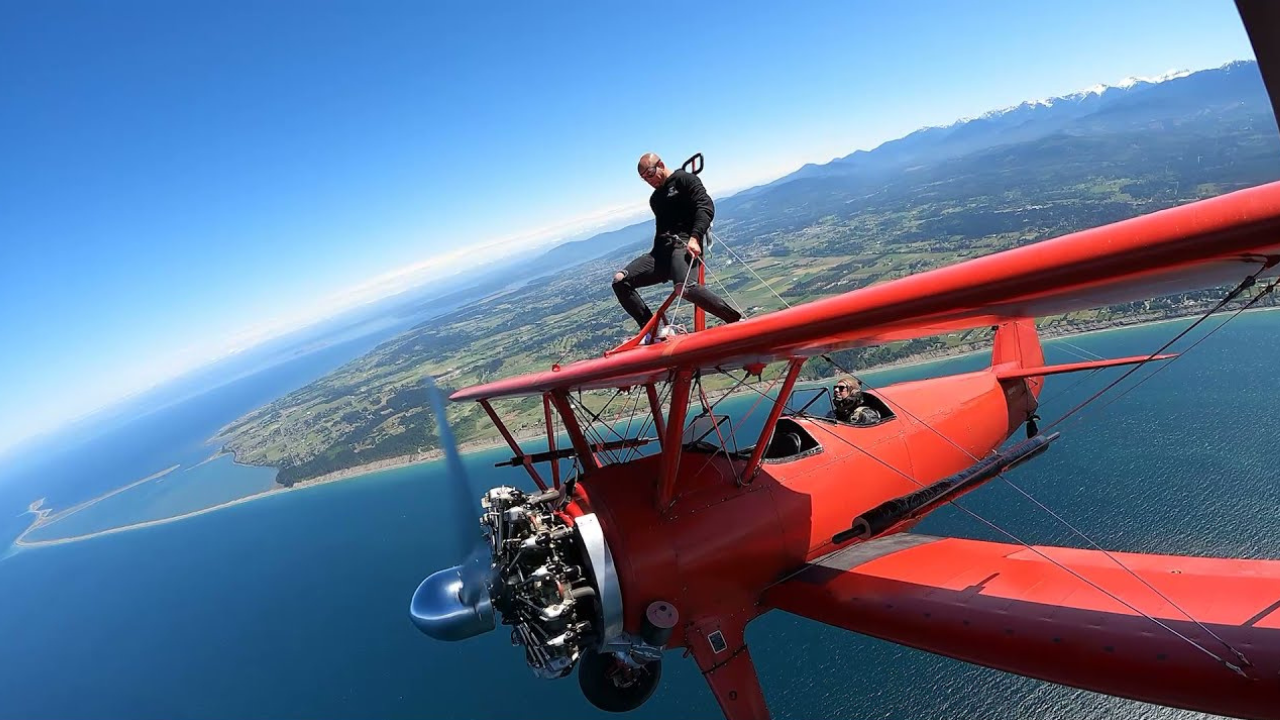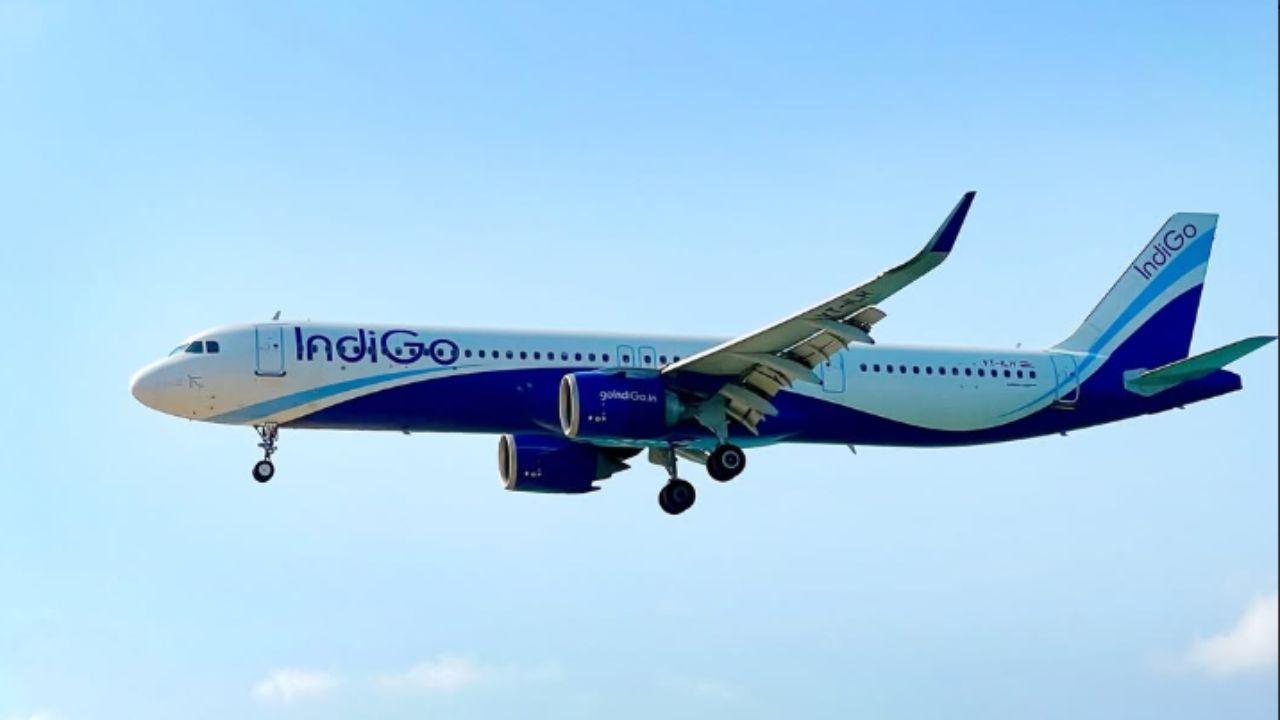
Post by: Kanchan Chandel
In today's world, where adrenaline-pumping activities are constantly evolving, one daredevil feat stands out as the ultimate aerial adventure: wing walking. This thrilling sport, which marries the rich history of aviation with the excitement of extreme sports, is captivating both thrill-seekers and spectators. With its unique blend of acrobatics, courage, and stunning views from thousands of feet above the ground, wing walking offers an experience unlike any other.
Wing walking has its roots in the barnstorming era of the 1920s. During this time, pilots and stunt performers would travel from town to town, dazzling audiences with their high-flying antics. To draw larger crowds, these daring individuals began performing stunts outside the cockpit, climbing onto the wings of biplanes while in flight. These early aerial shows were a testament to human bravery and innovation, setting the stage for the modern incarnation of wing walking.
Today, wing walking has transformed into a well-regulated extreme sport. While the risks remain high, modern wing walkers use safety harnesses and lines to prevent falls, ensuring that safety is a top priority. Despite these precautions, the essence of wing walking remains the same: performers balance, dance, and perform acrobatic feats on the wings of an aircraft as it soars through the sky.
Pilots are integral to these performances, executing dramatic maneuvers such as loops, rolls, and steep dives to enhance the visual spectacle. Wing walkers undergo extensive training to build the strength, balance, and trust necessary to perform these high-altitude stunts. The result is a seamless blend of human and machine, creating a breathtaking display that leaves audiences in awe.
Becoming a wing walker is no small feat. Aspiring performers undergo rigorous training, beginning with ground exercises to build physical and mental resilience. Once they are ready, they move on to practice sessions in the air, starting at lower altitudes to acclimate to the wind pressure and the aircraft's movements.
Veteran wing walkers describe the experience as both overwhelming and serene. The roar of the engine, the rush of wind, and the panoramic views combine to create a sensory overload that is both thrilling and beautiful. This unique experience demands not only physical prowess but also a deep connection to the aircraft and an unwavering focus.
Wing walking has become a highlight at airshows and aviation festivals worldwide. Events like the EAA AirVenture in Oshkosh, Wisconsin, and the Royal International Air Tattoo in the UK feature wing walkers, drawing massive crowds eager to witness these incredible stunts.
Teams like the famous Breitling Wingwalkers travel the globe, showcasing their skills and adding layers of complexity and artistry to their performances. These teams bring a combination of individual talent and synchronized stunts, creating a captivating spectacle for audiences everywhere.
What drives individuals to take up wing walking? For many, it represents the ultimate expression of freedom and daring—a chance to break free from earthly constraints and experience the world from an extraordinary vantage point. It’s also a tribute to the pioneering aviators who first dared to step out onto those wings nearly a century ago.
Wing walking continues to inspire new generations, captivating audiences with its blend of history, danger, and beauty. As technology advances and safety measures improve, the sport is becoming more accessible, inviting even more thrill-seekers to experience the exhilaration of wing walking.
Wing walking stands as a testament to human courage, creativity, and the unending quest for adventure. It bridges the gap between past and present, honoring the legacy of early aviators while pushing the boundaries of modern extreme sports. As more people seek out unique and exhilarating experiences, wing walking promises to remain a captivating spectacle, encouraging us all to look up and dream of soaring among the clouds.
Step back in time to the roaring 1920s, an era characterized by jazz, flapper dresses, and the electrifying phenomenon of barnstorming. Picture a small town fairground bustling with excitement as crowds gather to witness the latest spectacle in aviation entertainment: wing walking.
In those pioneering days of flight, when airplanes were still a marvel of modern engineering, daredevil pilots and thrill-seeking performers joined forces to captivate audiences with death-defying stunts. Barnstormers, as they were known, crisscrossed the country, transforming open fields into impromptu airfields and offering the public a glimpse into the thrilling world of aviation.
It was amidst this backdrop of excitement and innovation that wing walking emerged as a breathtaking showcase of human courage and ingenuity. Imagine the gasps of astonishment as spectators watched in awe as performers climbed out of the cockpit mid-flight, stepping onto the wings of biplanes soaring through the sky.
These early wing walkers, often adorned in flamboyant costumes, defied gravity as they balanced precariously on the wings, executing daring maneuvers that left audiences holding their breath. From daring somersaults to death-defying handstands, these aerial acrobats pushed the limits of what was thought possible, earning the admiration and applause of onlookers below.
But wing walking was more than just a spectacle—it was a testament to the human spirit of adventure and exploration. Pilots and performers alike pushed themselves to the edge, embracing the thrill of flight and the exhilaration of defying gravity. It was a world where bravery was celebrated, and each flight was a triumph of skill and daring.
As aviation technology advanced and safety regulations tightened, the golden age of barnstorming faded into memory. Yet, the spirit of wing walking lived on, evolving into a modern-day extreme sport that continues to thrill audiences around the world.
Today, wing walking is a carefully choreographed blend of adrenaline and artistry, with performers securely harnessed to the wings of specially modified aircraft. While the risks may have been mitigated, the sense of adventure and wonder remains as strong as ever.
From the iconic airshows of Oshkosh to the majestic skies of Europe, wing walking teams continue to inspire awe and admiration wherever they go. With synchronized routines and gravity-defying stunts, these modern-day daredevils pay homage to the pioneers of aviation while pushing the boundaries of what is possible in the air.
So the next time you look up and see a wing walker soaring gracefully through the sky, take a moment to appreciate the rich history and legacy behind this exhilarating spectacle. For in those fleeting moments of flight, we catch a glimpse not only of the past but also of the enduring human spirit that continues to reach for the stars.
In the heart-pounding world of modern wing walking, safety takes center stage without compromising the awe-inspiring spectacle. This electrifying fusion of aerial acrobatics and adrenaline-fueled stunts has captivated audiences worldwide, drawing enthusiasts and thrill-seekers alike into its exhilarating orbit.
Gone are the days of daredevils risking life and limb with only a flimsy rope tethering them to the aircraft. Today's wing walkers are securely harnessed and trained rigorously, ensuring they can perform their death-defying feats with confidence and precision.
Picture this: a brave individual strapped to the wing of a roaring biplane, soaring through the sky with grace and daring. With each twist, turn, and loop, they defy gravity, their movements choreographed to perfection against the backdrop of a vast, blue canvas.
But behind the scenes lies a meticulous approach to safety. Before taking flight, wing walkers undergo extensive training, honing their balance, strength, and agility. They familiarize themselves with the aircraft and its controls, forming a symbiotic partnership with their pilot counterpart.
During performances, safety measures are paramount. State-of-the-art harnesses and rigging systems keep wing walkers securely attached to the aircraft, while redundant safety checks provide an additional layer of reassurance. Pilots are trained professionals, adept at maneuvering their planes with precision and skill, ensuring a smooth and controlled experience for their daring passengers.
Yet, amid the focus on safety, the spectacle remains undeniably mesmerizing. Audiences watch in awe as wing walkers execute jaw-dropping maneuvers, their bodies defying gravity in a display of courage and artistry. It's a breathtaking marriage of human daring and technological prowess, a testament to the boundless possibilities of human achievement.
And as the sun sets on each performance, the legacy of wing walking endures, inspiring future generations to reach for the skies and embrace the thrill of adventure. In this modern era where safety meets spectacle, wing walking stands as a shining example of human ingenuity and the indomitable spirit of exploration.
Embarking on the journey from training to performance in the world of wing walking is an exhilarating odyssey, marked by dedication, courage, and an unyielding passion for the sky. Aspiring wing walkers first immerse themselves in ground exercises, honing their physical strength, balance, and mental focus to prepare for the airborne feats that lie ahead.
Picture them standing on solid ground, the wind whispering secrets of the skies, as they undergo rigorous exercises to build the muscle memory and agility required for the aerial ballet that awaits. Each step, each stretch, is a step closer to mastering the art of wing walking, a delicate dance between human and machine.
But the true magic unfolds when they take to the air, strapped securely to the wings of the aircraft, their hearts pounding in rhythm with the engine's roar. It's a moment of exhilaration and trepidation, as they feel the full force of the wind against their bodies, a reminder of the raw power of flight.
Guided by seasoned mentors, they navigate the complexities of aerial maneuvers, gradually ascending to higher altitudes as their confidence soars. They learn to anticipate the subtle shifts in air pressure, the exhilarating rush of adrenaline fueling their every move.
With each training session, they forge a deeper connection to the aircraft, learning to trust its movements as they push the boundaries of their own capabilities. They become attuned to the nuances of flight, instinctively adjusting their balance and posture to maintain harmony with the soaring machine beneath them.
And then, the moment arrives—their debut performance before a captivated audience, a symphony of motion and grace unfolding against the backdrop of the boundless sky. With every loop, roll, and daring maneuver, they defy gravity, embodying the spirit of freedom and adventure that defines wing walking.
It's a journey of self-discovery, of pushing beyond limits and embracing the thrill of the unknown. And as they glide gracefully through the air, they inspire others to reach for the stars, to chase their dreams with unwavering determination and boundless courage.
In the world of wing walking, the journey from training to performance is not just a progression—it's a transformation. It's about embracing the unknown, defying gravity, and soaring into the realm of endless possibilities. And for those who dare to take the leap, the sky is not the limit—it's just the beginning.
In the realm of aerial marvels, wing walking has carved its own niche as a captivating spectacle that transcends borders and cultures. From the bustling airshows of America to the historic airfields of Europe, wing walking shows have become a celebrated global phenomenon, drawing in audiences with their heart-stopping displays of bravery and skill.
Across continents, aviation enthusiasts and thrill-seekers alike flock to witness these awe-inspiring performances. The allure lies not just in the daring feats performed on the wings of aircraft but also in the camaraderie and teamwork displayed by the performers themselves.
In the United States, events like the legendary EAA AirVenture in Oshkosh, Wisconsin, serve as meccas for aviation aficionados. Against the backdrop of the sprawling airfield, wing walkers take to the skies, their vibrant routines punctuating the roar of engines and the flutter of flags. It’s a sensory symphony that leaves spectators spellbound, eager for more.
Across the Atlantic, the Royal International Air Tattoo in the UK offers a glimpse into the rich tapestry of aviation history. Here, amidst the rolling hills of the English countryside, wing walking teams from around the world converge to showcase their talents. Against the backdrop of historic airfields and majestic aircraft, these daredevils execute gravity-defying maneuvers, their performances a testament to human courage and ingenuity.
But wing walking isn’t just about the spectacle—it’s also about the sense of community that permeates these events. Pilots, performers, and spectators alike come together, united by their passion for flight and their shared appreciation for the daring art form unfolding before them.
At the heart of it all are the wing walkers themselves—athletes and aerial artists who push the boundaries of what’s possible. With each graceful step and daring maneuver, they capture the imaginations of onlookers, inspiring awe and admiration in equal measure.
As the sun sets on another day of breathtaking displays and unforgettable moments, one thing becomes clear: wing walking isn’t just a show—it’s a celebration of human daring and the unquenchable spirit of adventure. And as long as there are skies to conquer and dreams to chase, wing walking will continue to soar as a global sensation, captivating hearts and minds wherever it goes.
In a world where the ordinary often reigns supreme, there exists a realm where the extraordinary takes flight—the exhilarating domain of wing walking. Imagine stepping out onto the wing of a plane, wind whipping around you as you dance through the sky, defying gravity and embracing pure freedom. It’s a daring spectacle that beckons to the adventurous spirit within us all.
To understand the allure of wing walking is to immerse oneself in a symphony of senses. Picture the roar of the engine as it propels you forward, the rush of wind against your skin as you soar through the heavens, and the panoramic vista unfolding beneath you like a living tapestry. It’s a sensory feast unlike any other, where every moment is infused with adrenaline and awe.
At its core, wing walking is a testament to human courage—the willingness to step beyond the confines of safety and embrace the unknown. It takes a special kind of individual to strap themselves to the wing of a plane and trust in the pilot and the equipment with unwavering faith. Yet, for those who dare to take the leap, the rewards are immeasurable.
Wing walking is more than just a physical feat; it’s a dance with destiny—a graceful choreography of human and machine against the backdrop of the boundless sky. Every twist, turn, and somersault is a testament to the human spirit’s capacity for daring and innovation. It’s a celebration of what is possible when we push beyond our limits and embrace the unknown.
In many ways, wing walking is a tribute to the pioneers of aviation who first took to the skies in flimsy contraptions of wood and fabric. It harkens back to a time when the very idea of flight was little more than a dream—a testament to the human spirit’s indomitable desire to conquer the skies. Yet, even as we honor the past, wing walking also represents a vision for the future—a future where the boundaries of human achievement are limited only by our imagination.
For those who yearn to break free from the bonds of gravity and embrace the thrill of flight, wing walking offers an invitation to join the skyward symphony. It’s a call to adventure that resonates deep within the soul—a reminder that the greatest rewards often lie just beyond the horizon. So, if you’ve ever dreamed of dancing among the clouds, of defying gravity and embracing pure freedom, then perhaps it’s time to take the leap and experience the irresistible allure of wing walking for yourself.
The article delves into the thrilling world of wing walking, an aerial spectacle that combines aviation history with extreme sports. From its origins in the barnstorming era of the 1920s to its modern-day incarnation as a well-regulated extreme sport, wing walking continues to captivate audiences with its blend of acrobatics, courage, and breathtaking views. The piece explores the training and preparation required for aspiring wing walkers, the safety measures in place during performances, and the global appeal of wing walking shows at airshows and aviation festivals. It highlights the allure of wing walking as an expression of freedom and daring, paying tribute to the pioneers of aviation while inspiring future generations to embrace the thrill of flight.
The views and opinions expressed in this article are those of the author and do not necessarily reflect the official policy or position of DXB News Network. Readers are encouraged to conduct their own research and seek professional advice before attempting any aerial stunts or extreme sports activities. DXB News Network shall not be held liable for any injuries, accidents, or damages resulting from the implementation of the information provided in this article. Safety should always be the top priority when engaging in adventurous pursuits.
#trending #latest #WingWalkingAdventure #SkyHighThrills #DaredevilDelight #FlyingFeats #AerialArtistry #AdventureAboveClouds #WingWalkingWonder #ExtremeSkySpectacle #AviationAdrenaline #GravityDefyingActs #breakingnews #worldnews #headlines #topstories #globalUpdate #dxbnewsnetwork #dxbnews #dxbdnn #dxbnewsnetworkdnn #bestnewschanneldubai #bestnewschannelUAE #bestnewschannelabudhabi #bestnewschannelajman #bestnewschannelofdubai #popularnewschanneldubai

Dubai lit up Ain Dubai with Sikandar visuals ahead of its release! Salman Khan’s Eid action blockbuster is finally in theatres. Don’t miss the spectacle...Read More.

An IndiGo flight from Patna to Delhi made an emergency landing in Lucknow after an elderly passenger's health deteriorated mid-air...Read More.














Small Plane Crashes into House in Minneapolis Suburb
A small plane from Iowa to Minnesota crashed into a house near Brooklyn Park. No survivors on board;

Partial Solar Eclipse to Be Visible Across Northern Hemisphere
A partial solar eclipse will be visible on Saturday from Canada to Siberia, with the best views in n

Milos Uzan’s Clutch Layup Sends Houston to Elite Eight
Milos Uzan’s last-second layup lifts Houston over Purdue 62-60, securing a spot in the Elite Eight a

Abu Dhabi Introduces CASGEVY: First Gene-Editing Therapy
DoH Abu Dhabi launches CASGEVY, the UAE’s first CRISPR gene therapy, revolutionizing treatment for s

Chelsea Eliminate Man City to Reach Women’s Champions League Semis
Chelsea beat Man City 3-0, overturning a two-goal deficit to reach the Women’s Champions League semi